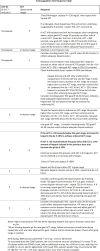Use of Thromboelastography to Predict Thrombotic Complications in Pediatric and Neonatal Extracorporeal Membranous Oxygenation
- PMID: 30250340
- PMCID: PMC6146278
Use of Thromboelastography to Predict Thrombotic Complications in Pediatric and Neonatal Extracorporeal Membranous Oxygenation
Abstract
The objectives of this study were to investigate the correlation between thromboelastography (TEG) and conventional measures of anticoagulation, and to determine optimum values for citrated kaolin TEG R time (TEG RCK) and anti-Xa activity that would minimize both bleeding and thrombotic complications in pediatric and neonatal patients requiring extracorporeal membranous oxygenation (ECMO). A retrospective chart review of patients requiring veno-venous (VV) and venoarterial (VA) ECMO was performed. Combined medical and cardiac ICU within a single-center, tertiary care, freestanding, children's hospital. Non-pregnant patients <18 years and >2 kilograms requiring VV or VA ECMO from July 2013 through July 2015. Anti-Xa (OR = 0.62, 95% CI 0.53-0.72, p < .001) and TEG RCK (OR = 1.19, 95% CI 1.07-1.34, p = .003) were the only independent predictors for a significant thrombotic event. Receiver operating characteristic curves and traditional epidemiological data (sensitivity, specificity, PPV, NPV) were used to determine optimal target Anti-Xa and TEG RCK values. No independent predictors for significant bleeding events were identified in this cohort. A anti-Xa activity of .25 IU/mL (sensitivity = 81%, specificity = 67%, PPV = 81%, NPV = 58%) and TEG RCK time of 17.85 minutes (sensitivity = 84%, specificity = 68%, PPV = 82%, NPV = 59%) were established as the optimal thresholds for preventing thrombotic events. Anti-Xa and TEG RCK were independent predictors of thrombosis in this cohort of pediatric and neonatal ECMO patients. Targeting an anti-Xa activity greater than .25 IU/mL and a TEG RCK greater than 17.85 minutes may minimize the risk of thrombosis in pediatric and neonatal ECMO patients. Future investigation should evaluate targets for anti-Xa and TEG RCK, which additionally minimize the risk of significant bleeding in this patient population.
Keywords: extracorporeal membrane oxygenation; heparin management; neonatal; pediatrics; thromboelastography; thrombosis.
Figures
Similar articles
-
Anti-Xa versus time-guided anticoagulation strategies in extracorporeal membrane oxygenation: a systematic review and meta-analysis.Perfusion. 2021 Jul;36(5):501-512. doi: 10.1177/0267659120952982. Epub 2020 Aug 29. Perfusion. 2021. PMID: 32862767 Free PMC article.
-
Anticoagulation Monitoring Strategies During Extracorporeal Membrane Oxygenation (ECMO) Therapy - Differences Between Simultaneously Obtained Coagulation Tests: A Retrospective Single-Center Cohort Study.J Intensive Care Med. 2025 Jun;40(6):651-659. doi: 10.1177/08850666241313357. Epub 2025 Feb 6. J Intensive Care Med. 2025. PMID: 39911077
-
Hemostasis, coagulation and thrombin in venoarterial and venovenous extracorporeal membrane oxygenation: the HECTIC study.Sci Rep. 2021 Apr 12;11(1):7975. doi: 10.1038/s41598-021-87026-z. Sci Rep. 2021. PMID: 33846433 Free PMC article. Clinical Trial.
-
The Use of Recombinant Antithrombin III in Pediatric and Neonatal ECMO Patients.ASAIO J. 2017 Jan/Feb;63(1):93-98. doi: 10.1097/MAT.0000000000000476. ASAIO J. 2017. PMID: 27861430
-
Anti-Xa-guided Anticoagulation With Unfractionated Heparin and Thrombosis During Extracorporeal Membrane Oxygenation Support: A Systematic Review and Meta-analysis.J Cardiothorac Vasc Anesth. 2024 Aug;38(8):1662-1672. doi: 10.1053/j.jvca.2024.03.042. Epub 2024 Apr 2. J Cardiothorac Vasc Anesth. 2024. PMID: 38839489
Cited by
-
Anti-Xa versus time-guided anticoagulation strategies in extracorporeal membrane oxygenation: a systematic review and meta-analysis.Perfusion. 2021 Jul;36(5):501-512. doi: 10.1177/0267659120952982. Epub 2020 Aug 29. Perfusion. 2021. PMID: 32862767 Free PMC article.
-
Neonatal respiratory and cardiac ECMO in Europe.Eur J Pediatr. 2021 Jun;180(6):1675-1692. doi: 10.1007/s00431-020-03898-9. Epub 2021 Feb 5. Eur J Pediatr. 2021. PMID: 33547504 Free PMC article. Review.
-
Viscoelastic coagulation testing in Neonatal Intensive Care Units: advantages and pitfalls in clinical practice.Blood Transfus. 2023 Nov 13;21(6):538-548. doi: 10.2450/2023.0203-22. Blood Transfus. 2023. PMID: 36795342 Free PMC article. Review.
-
Subtypes and Mechanistic Advances of Extracorporeal Membrane Oxygenation-Related Acute Brain Injury.Brain Sci. 2023 Aug 4;13(8):1165. doi: 10.3390/brainsci13081165. Brain Sci. 2023. PMID: 37626521 Free PMC article. Review.
-
Clinical controversies in anticoagulation monitoring and antithrombin supplementation for ECMO.Crit Care. 2020 Jan 20;24(1):19. doi: 10.1186/s13054-020-2726-9. Crit Care. 2020. PMID: 31959232 Free PMC article. Review.
References
-
- Kessel AD, Kline M, Zinger M, et al. . The impact and statistical analysis of a multifaceted anticoagulation strategy in children supported on ECMO: Performance and pitfalls. J Intensive Care Med. 2015;32:60. - PubMed
-
- Dalton HJ, Macrae DJ; Pediatric Acute Lung Injury Consensus Conference Group. Extracorporeal support in children with pediatric acute respiratory distress syndrome: Proceedings from the pediatric acute lung injury consensus conference. Pediatr Crit Care Med. 2015;16(5 Suppl 1):S111–7. - PubMed
-
- Oliver WC. Anticoagulation and coagulation management for ECMO. Semin Cardiothorac Vasc Anesth. 2009;13:154–75. - PubMed
-
- Bolliger D, Zenklusen U, Tanaka KA. Point-of-care coagulation management algorithms during ECMO support: Are we there yet? Minerva Anestesiol. 2016;82:1008–9. - PubMed
MeSH terms
Substances
LinkOut - more resources
Full Text Sources
Medical


